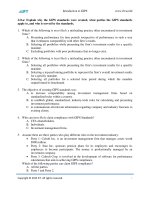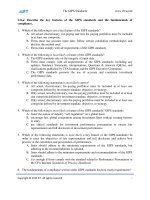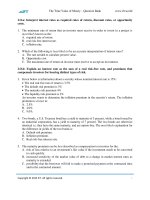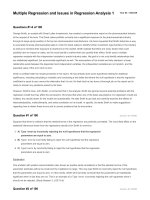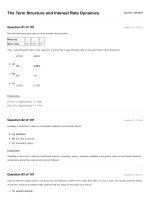CFA 2018 question bank 02 the arbitrage free valuation framework
Bạn đang xem bản rút gọn của tài liệu. Xem và tải ngay bản đầy đủ của tài liệu tại đây (167.26 KB, 18 trang )
The Arbitrage-Free Valuation Framework
Test ID: 7441665
Question #1 of 38
Question ID: 472602
Tim Brospack is generating a binomial interest rate tree assuming a volatility of 15%. Current 1-year spot rate is 5%. The 1year forward rate in the second year is either a low estimate of 5.250% or a high estimate of 7.087%.The middle 1-year
forward rate in year three is estimated at 6.25%. The lower node 1-year forward rate in year three is closest to:
ᅚ A) 4.63%
ᅞ B) 6.747%
ᅞ C) 5.342%
Explanation
Lower node interest rate = 6.25 / e2x0.15 = 4.63%
Question #2 of 38
Question ID: 463785
The volatility assumption in a Monte Carlo simulation is important, because it determines the:
ᅞ A) speed of prepayments.
ᅞ B) level of prepayments.
ᅚ C) dispersion of future interest rates and the number of possible paths that may be followed.
Explanation
The volatility assumption in a Monte Carlo simulation is important because it determines the dispersion of future interest rates and the
number of possible paths that may be followed.
Question #3 of 38
Question ID: 472694
Relative to the binomial model, Monte Carlo method is most likely:
ᅚ A) more suitable when valuing securities whose cash flows are interest rate path
dependent.
ᅞ B) more flexible as it does not need a volatility estimate.
ᅞ C) less flexible in forcing interest rates to mean revert.
Explanation
Monte Carlo method does not require that cash flows of a security are path dependent and hence is suitable alternative to the
binomial model to value securities such as mortgage backed securities whose cash flows are path dependent. The model
generating interest rates paths in a Monte Carlo simulation is based on an assumed level of volatility (i.e., model needs a
volatility input). The model generating interest rates in a Monte Carlo simulation can incorporate bounds for interest rates to
force mean reversion of rates. Such bounded optimization is not possible in a binomial model.
Question #4 of 38
Question ID: 463765
The purpose of relative value analysis is to determine:
ᅞ A) the return differential from riding the yield curve.
ᅚ B) whether a bond is fairly valued using a benchmark yield.
ᅞ C) whether a stock is fairly valued using present value calculations.
Explanation
The purpose of relative value analysis is to determine whether a bond is fairly valued. The bond's spread over some
benchmark is compared to that of a required spread to determine whether the bond is fairly valued. The required spread will
be that available on comparable securities.
Question #5 of 38
Question ID: 463774
Which of the following is a correct statement concerning the backward induction technique used within the binomial interest rate tree
framework? From the maturity date of a bond:
ᅞ A) the corresponding interest rates are weighted by the bond's duration to discount the
value of the bond.
ᅞ B) a deterministic interest rate path is used to discount the value of the bond.
ᅚ C) the corresponding interest rates and interest rate probabilities are used to discount the value
of the bond.
Explanation
For a bond that has N compounding periods, the current value of the bond is determined by computing the bond's possible values at
period N and working "backwards" to the present. The value at any given node is the probability-weighted average of the discounted
values of the next period's nodal values.
Question #6 of 38
Question ID: 463771
With respect to interest rate models, backward induction refers to determining:
ᅞ A) convexity from duration.
ᅞ B) one portion of the yield curve from another portion.
ᅚ C) the current value of a bond based on possible final values of the bond.
Explanation
Backward induction refers to the process of valuing a bond using a binomial interest rate tree. For a bond that has N compounding
periods, the current value of the bond is determined by computing the bond's possible values at period N and working "backwards."
Questions #7-12 of 38
Dawn Adams, CFA, along with her recently hired staff, have responsibilities that require them to be familiar with backward
induction methodology as it is used with a binomial valuation model. Adams, however, is concerned that some of her staff,
particularly those not enrolled in the CFA program, are a little weak in this area. To assess their understanding of the binomial
model and its uses, Adams presented her staff with the first two years of the binomial interest rate tree for an 8% annually
compounded bond (shown below). The forward rates and the corresponding values shown in this tree are based on an
assumed interest rate volatility of 20%.
A member of Adams" staff has been asked to respond to the following:
Question #7 of 38
Question ID: 463776
Compute V1L, the value of the bond at node 1L.
ᅞ A) $101.05.
ᅞ B) $95.99.
ᅚ C) $103.58.
Explanation
V1L = (½)[(V2LU + C) / (1 + r1L)] + [(V2,LL + C) / (1 + r1L)]
V1L = (½)[(99.455 + 8) / (1 + 0.05331)] + [(102.755 + 8) / (1 + 0.05331)] = $103.583
(Study Session 14, LOS 47.i)
Question #8 of 38
Compute V1U, the value of the bond at node 1U.
ᅞ A) $91.72.
ᅞ B) $99.01.
ᅚ C) $99.13.
Explanation
V1U = (½)[(V2,UU + C) / (1 + r1U )] + [(V2,UL + C)/(1 + r1U )]
V1U = (½)[(98.565 + 8) / (1 + 0.079529)] + [(99.455 + 8) / (1 + 0.079529)] = $99.127
Question ID: 463777
(Study Session 14, LOS 47.i)
Question #9 of 38
Question ID: 463778
Compute V0, the value of the bond at node 0.
ᅚ A) $104.76.
ᅞ B) $99.07.
ᅞ C) $101.35.
Explanation
V0 = (½)[(V1U + C) / (1 + r0)] + [(V1L + C) / (1 + r0)]
From the previous question the value for V1U was determined to be $99.127
V0 = (½)[(99.127 + 8) / (1 + 0.043912)] + [(103.583 + 8)/(1 + 0.043912)] = $104.755
(Study Session 14, LOS 47.i)
Question #10 of 38
Question ID: 463779
Assume that the bond is putable in one year at par ($100) and that the put will be exercised if the computed value is less than
par. What is the value of the putable bond?
ᅚ A) $105.17.
ᅞ B) $103.04.
ᅞ C) $95.38.
Explanation
The relevant value to be discounted using a binomial model and backward induction methodology for a putable bond is the
value that will be received if the put option is exercised or the computed value, whichever is greater.
In this case, the relevant value at node 1U is the exercise price ($100.000) since it is greater than the computed value of
$99.127. At node 1L, the computed value of $103.583 must be used.
Therefore, the value of the putable bond is:
V0 = (½)[(100.00 + 8) / (1 + 0.043912)] + [(103.583 + 8) / (1 + 0.043912)] = $105.17314
(Study Session 14, LOS 47.i)
Question #11 of 38
Question ID: 463780
Assume that the bond is putable in one year at par ($100) and that the put will be exercised if the computed value is less than
par. What is the value of the put option?
ᅚ A) $0.42.
ᅞ B) $3.70.
ᅞ C) $1.86.
Explanation
Vputable = Vnonputable + Vput
Rearranging, the value of the put can be stated as:
Vput = Vputable − Vnonputable
Vputable was computed to be $105.173 in the previous question, and Vnonputable was determined to be $104.755 in the question
prior to that. So the value of the embedded put option for the bond under analysis is:
$105.173 − 104.755 = $0.418
(Study Session 14, LOS 47.e, i)
Question #12 of 38
Question ID: 463781
Which of the following statements regarding the option adjusted spread (OAS) for a callable bond is least accurate?
ᅞ A) The OAS is the spread on a bond with an embedded option after the embedded
option cost has been removed.
ᅚ B) The OAS is equal to the Z-spread plus the option cost.
ᅞ C) The OAS for a corporate bond must be calculated using a binomial interest rate
model.
Explanation
The OAS is equal to the Z-spread minus the option cost. Both of the other choices are true statements. (Study Session 14,
LOS 47.g)
Question #13 of 38
Question ID: 463770
Why is the backward induction methodology used to value a bond rather than a forward induction scheme?
ᅚ A) The price of the bond is known at maturity.
ᅞ B) The convexity of a bond changes over time.
ᅞ C) Future interest rate changes are difficult to forecast.
Explanation
The objective is to value a bond's current price while the bond price at maturity is known. Therefore, price at maturity is used as a starting
point, and we work backward to the current value.
Question #14 of 38
Question ID: 472691
A 3-year, 3% annual pay, $100 par bond is valued using pathwise valuation. The interest rate paths are provided below:
Path
Year 1
Year 2
Year 3
1
2%
2.8050%
4.0787%
2
2%
2.8050%
3.0216%
3
2%
2.0780%
3.0216%
4
2%
2.0780%
2.2384%
The value of the bond in path 2 is closest to:
ᅚ A) $101.15
ᅞ B) $100.88
ᅞ C) $102.72
Explanation
Path 2 value =
Question #15 of 38
Question ID: 472688
For a 3-year, semiannual coupon payment bond, the number of interest rate paths that would be generated using the
pathwise valuation is closest to:
ᅞ A) 64
ᅞ B) 4
ᅚ C) 32
Explanation
For a 3-year, semiannual coupon bond, there will be six nodal periods resulting in 2(6-1) = 32 paths.
Question #16 of 38
Question ID: 463783
A putable bond with a 6.4% annual coupon will mature in two years at par value. The current one-year spot rate is 7.6%. For the second
year, the yield volatility model forecasts that the one-year rate will be either 6.8% or 7.6%. The bond is putable in one year at 99. Using a
binomial interest rate tree, what is the current price?
ᅞ A) 98.885.
ᅞ B) 98.190.
ᅚ C) 98.246.
Explanation
The tree will have three nodal periods: 0, 1, and 2. The goal is to find the value at node 0. We know the value at all nodes in nodal period
2: V2=100. In nodal period 1, there will be two possible prices:
Vi,U = [(100 + 6.4) / 1.076 + (100+6.4) / 1.076] / 2 = 98.885
Vi,L = [(100 + 6.4) / 1.068 + (100 + 6.4) / 1.068] / 2 = 99.625.
Since 98.885 is less than the put price, Vi,U = 99
V0 = [(99 + 6.4) / 1.076) + (99.625 + 6.4) / 1.076)] / 2 = 98.246.
Question #17 of 38
Question ID: 463764
The following are the yields on various bonds. The relevant benchmark is that of Treasury securities.
Treasury Bond Yield
4.00%
Bond Sector Yield
4.50%
Comparable Bond Yield
6.00%
ABC Bond Yield
6.50%
Is the ABC bond undervalued or overvalued and why? Using relative value analysis, the ABC bond is:
ᅞ A) overvalued because its spread is greater than that of comparable bonds.
ᅚ B) undervalued because its spread is greater than that of comparable bonds.
ᅞ C) undervalued because its yield is greater than that of Treasuries.
Explanation
The purpose of relative value analysis is to determine whether a bond is fairly valued. The bond's spread over some
benchmark is compared to that of a required spread to determine whether the bond is fairly valued. The required spread will
be that available on comparable securities. In this example, the relevant benchmark was Treasury securities. The spread for
ABC bonds over Treasuries was 2.5%. The spread for comparable bonds over Treasuries was 2.0%. The higher spread for
ABC bonds means that they are relatively undervalued (their price is low because their yield is higher).
Question #18 of 38
Question ID: 472599
Which of the following choices is least-likely a property of a binomial interest rate tree?
ᅚ A) Mean reversion of interest rates.
ᅞ B) Non-negative interest rates.
ᅞ C) Higher volatility at higher rates.
Explanation
A binomial interest rate tree has two desirable properties: non-negative interest rates and higher volatility at higher rates.
Binomial trees do not force mean reversion of rates.
Question #19 of 38
Question ID: 463766
The following are the yields on various bonds. The relevant benchmark is that of the bond sector.
Treasury Bond Yield
3.00%
Bond Sector Yield
3.25%
Comparable Bond Yield
5.75%
ABC Bond Yield
5.50%
Is the ABC bond undervalued or overvalued and why? Using relative value analysis, the ABC bond is:
ᅞ A) undervalued because its spread is less than that of comparable bonds.
ᅚ B) overvalued because its spread is less than that of comparable bonds.
ᅞ C) undervalued because its yield is less than that of Treasuries.
Explanation
The purpose of relative value analysis is to determine whether a bond is fairly valued. The bond's spread over some
benchmark is compared to that of a required spread to determine whether the bond is fairly valued. The required spread will
be that available on comparable securities. In this example, the relevant benchmark was the bond sector. The spread for ABC
bonds over the bond sector was 2.25%. The spread for comparable bonds over the bond sector was 2.50%. The lower spread
for ABC bonds means that they are relatively overvalued (their price is high because their yield is lower).
Question #20 of 38
Question ID: 477718
Sam Roit, CFA, has collected the following information on the par rate curve, spot rates, and forward rates to generate a
binomial interest rate tree consistent with this data.
Maturity
Par Rate
Spot Rate
1
5%
5.000%
2
6%
6.030%
3
7%
7.097%
The binomial tree generated is shown below (one year forward rates) assuming a volatility level of 10%:
0
1
5%
2
7.7099%
C
A
9.2625%
B
Riot also generated another tree using the same spot rates but this time assuming a volatility level of 20% as shown below:
0
5%
1
2
8.9480%
13.8180%
5.9980%
9.2625%
6.2088%
The one-year forward rate represented by 'C' is closest to:
ᅞ A) 7.4223%
ᅚ B) 11.3132%
ᅞ C) 8.7732%
Explanation
Value represented by 'C' = 9.2625 x e2x0.10 = 11.3132%
Question #21 of 38
Increasing the number of paths generated in a Monte Carlo simulation is most likely to increase the:
Question ID: 472693
ᅞ A) utility of the model.
ᅞ B) fundamental accuracy of the estimated value.
ᅚ C) statistical accuracy of the estimated value.
Explanation
Increasing the number of paths would increase the statistical accuracy of the estimate but does nothing for the fundamental
accuracy of the estimated value which depends on the quality of model inputs. Model utility depends on valuation accuracy of
the model and hence would not increase as we increase the number of paths.
Question #22 of 38
Question ID: 472604
Sam Roit, CFA, has collected the following information on the par rate curve, spot rates, and forward rates to generate a
binomial interest rate tree consistent with this data.
Maturity
Par Rate
Spot Rate
1
5%
5.000%
2
6%
6.030%
3
7%
7.097%
The binomial tree generated is shown below (one year forward rates) assuming a volatility level of 10%:
0
1
5%
2
7.7099%
C
A
9.2625%
B
Riot also generated another tree using the same spot rates but this time assuming a volatility level of 20% as shown below:
0
1
5%
2
8.9480%
13.8180%
5.9980%
9.2625%
6.2088%
The one-year forward rate represented by 'A' is closest to:
ᅚ A) 6.3123%
ᅞ B) 5.4223%
ᅞ C) 6.7732%
Explanation
Value represented by 'A' = 7.7099 / e2x0.10 = 6.3123%
Question #23 of 38
Question ID: 472689
A 3-year, 3% annual pay, $100 par bond is valued using pathwise valuation. The interest rate paths are provided below:
Path
Year 1
1
2%
Year 2
2.8050%
Year 3
4.0787%
2
2%
2.8050%
3.0216%
3
2%
2.0780%
3.0216%
4
2%
2.0780%
2.2384%
The value of the bond in path 3 is closest to:
ᅚ A) $101.85
ᅞ B) $99.88
ᅞ C) $100.02
Explanation
Answer: Path 3 value =
Question #24 of 38
Question ID: 463768
Using the following interest rate tree of semiannual interest rates what is the value of an option free semiannual bond that has one year
remaining to maturity and has a 6% coupon rate?
6.53%
6.30%
5.67%
ᅞ A) 97.53.
ᅚ B) 99.89.
ᅞ C) 98.52.
Explanation
The option-free bond price tree is as follows:
100.00
A ==> 99.79
99.89
100.00
100.20
100.00
As an example, the price at node A is obtained as follows:
PriceA = (prob × (Pup + coupon/2) + prob × (Pdown + coupon/2))/(1 + rate)0.5 = (0.5 × (100 + 3) + 0.5 × (100 + 3))/(1 + 0.0653)0.5 = 99.79.
The bond values at the other nodes are obtained in the same way.
The calculation for node 0 or time 0 is
0.5[(99.79 + 3)/(1+ 0.063)0.5 + (100.20 + 3)/(1 + 0.063)0.5] =
99.89
Question #25 of 38
Question ID: 472601
Tim Brospack is generating a binomial interest rate tree assuming a volatility of 15%. Current 1-year spot rate is 5%. The 1year forward rate in the second year is either a low estimate of 5.250% or a high estimate of 7.087%. The middle 1-year
forward rate in year three is estimated at 6.25%. The upper node 1-year forward rate in year three is closest to:
ᅞ A) 7.747%
ᅞ B) 6.445%
ᅚ C) 8.437%
Explanation
Upper node interest rate = 6.25 × e2x0.15 = 8.437%
Question #26 of 38
Question ID: 472600
Which of the following choices is least-likely a property of a binomial interest rate tree?
ᅚ A) Adjacent forward rates in a nodal period are one standard deviation apart.
ᅞ B) Higher volatility at higher rates.
ᅞ C) Non-negative interest rates.
Explanation
A binomial interest rate tree has two desirable properties: non-negative interest rates and higher volatility at higher rates.
Additionally, adjacent forward rates in a nodal period are two standard deviations apart.
Question #27 of 38
Question ID: 472692
A 3-year, 3% annual pay, $100 par bond is valued using pathwise valuation. The interest rate paths are provided below:
Path
Year 1
Year 2
Year 3
1
2%
2.8050%
4.0787%
2
2%
2.8050%
3.0216%
3
2%
2.0780%
3.0216%
4
2%
2.0780%
2.2384%
The value of the bond in path 1 is closest to:
ᅞ A) $98.77
ᅚ B) $100.18
ᅞ C) $101.88
Explanation
Path 1 value =
Question #28 of 38
Question ID: 463782
A callable bond with an 8.2% annual coupon will mature in two years at par value. The current one-year spot rate is 7.9%. For the second
year, the yield-volatility model forecasts that the one-year rate will be either 6.8% or 7.6%. The call price is 101. Using a binomial interest
rate tree, what is the current price?
ᅚ A) 101.000.
ᅞ B) 100.279.
ᅞ C) 100.558.
Explanation
The tree will have three nodal periods: 0, 1, and 2. The goal is to find the value at node 0. We know the value for all the nodes in nodal
period 2: V2=100. In nodal period 1, there will be two possible prices:
V1,U =[(100+8.2)/1.076+(100+8.2)/1.076]/2 = 100.558
V1,L =[(100+8.2)/1.068+(100+8.2)/1.068]/2= 101.311
Since V1,L is greater than the call price, the call price is entered into the formula below:
V0=[(100.558+8.2)/1.079)+(101+8.2)/1.079)]/2 = 101.000.
Question #29 of 38
Question ID: 463769
For a putable bond, callable bond, or putable/callable bond, the nodal-decision process within the backward induction methodology of the
interest rate tree framework requires that at each node the possible values will:
ᅚ A) not be higher than the call price or lower than the put price.
ᅞ B) include the face value of the bond.
ᅞ C) be, in number, two plus the number of embedded options.
Explanation
At each node, there will only be two values. At each node, the analyst must determine if the initially calculated values will be below the
put price or above the call price. If a calculated value falls below the put price: Vi,U = the put price. Likewise, if a calculated value falls
above the call price, then Vi,L = the call price. Thus the put and call price are lower and upper limits, respectively, of the bond's value at a
node.
Question #30 of 38
Question ID: 463767
Using the following interest rate tree of semiannual interest rates what is the value of an option free bond that has one year
remaining to maturity and has 5% coupon rate with semi-annual coupon payments.
Today
6 Months
7.30%
6.20%
5.90%
ᅞ A) 97.53.
ᅞ B) 98.98.
ᅚ C) 98.67.
Explanation
The option-free bond price tree is as follows:
100.00
A → 98.89
98.67
100.00
99.56
100.00
As an example, the price at node A is obtained as follows:
PriceA = (prob × (Pup + (coupon / 2)) + prob × (Pdown + (coupon / 2)) / (1 + (rate / 2)) = (0.5 × (100 + 2.5) + 0.5 × (100 + 2.5) / (1 + (0.0730
/ 2)) = 98.89. The bond values at the other nodes are obtained in the same way.
The calculation for node 0 or time 0 is
0.5[(98.89 + 2.5) / (1+ 0.062 / 2) + (99.56 + 2.5) / (1 + 0.062 / 2)] =
0.5(98.3414 + 98.9913) = 98.6663
Question #31 of 38
Question ID: 472597
The government bond spot rate curve is given below:
Maturity (years)
Spot rate
0.5
1.25%
1.0
1.30%
1.5
1.80%
2.0
2.00%
2.5
2.20%
3.0
2.25%
3.5
2.28%
4.0
2.30%
Compute the issue price of a 3-year, 3% semiannual coupon government bond with a par value of $100.
ᅞ A) $102.15
ᅞ B) $104.09
ᅚ C) $102.20
Explanation
Value =
= $102.20
Question #32 of 38
Question ID: 463784
A bond with a 10% annual coupon will mature in two years at par value. The current one-year spot rate is 8.5%. For the second year, the
yield volatility model forecasts that the one-year rate will be either 8% or 9%. Using a binomial interest rate tree, what is the current price?
ᅚ A) 102.659.
ᅞ B) 101.837.
ᅞ C) 103.572.
Explanation
The tree will have three nodal periods: 0, 1, and 2. The goal is to find the value at node 0. We know the value in nodal period 2: V2=100. In
nodal period 1, there will be two possible prices:
V1,U=[(100+10)/1.09+(100+10)/1.09]/2= 100.917
V1,L=[(100+10)/1.08+(100+10)/1.08]/2= 101.852
Thus
V0=[(100.917+10)/1.085+(101.852+10)/1.085]/2= 102.659
Question #33 of 38
Question ID: 472690
A 3-year, 3% annual pay, $100 par bond is valued using pathwise valuation. The interest rate paths are provided below:
Path
Year 1
Year 2
Year 3
1
2%
2.8050%
4.0787%
2
2%
2.8050%
3.0216%
3
2%
2.0780%
3.0216%
4
2%
2.0780%
2.2384%
The value of the bond in path 4 is closest to:
ᅞ A) $100.02
ᅞ B) $101.88
ᅚ C) $102.58
Explanation
Path 4 value =
Question #34 of 38
Question ID: 472603
Sam Roit, CFA, has collected the following information on the par rate curve, spot rates, and forward rates to generate a
binomial interest rate tree consistent with this data.
Maturity
Par Rate
Spot Rate
1
5%
5.000%
2
6%
6.030%
3
7%
7.097%
The binomial tree generated is shown below (one year forward rates) assuming a volatility level of 10%:
0
1
5%
2
7.7099%
C
A
9.2625%
B
Riot also generated another tree using the same spot rates but this time assuming a volatility level of 20% as shown below:
0
1
5%
2
8.9480%
13.8180%
5.9980%
9.2625%
6.2088%
Is the binomial tree using the 20% volatility assumption calibrated properly?
ᅞ A) The tree is calibrated properly.
ᅞ B) The tree is not calibrated properly because adjacent nodes are not appropriate
standard deviations apart.
ᅚ C) The tree is not calibrated properly because it is not consistent with market prices.
Explanation
The tree is not calibrated properly - it does not value 3-year 7% bond at par (i.e., the market price):
V2,UU =
V2,UL =
V2,LL =
V1,U =
V1,L =
V0 =
The adjacent nodes in the binomial tree for any nodal period are all two standard deviations apart.
Question #35 of 38
Question ID: 463773
Which of the following is the appropriate "nodal decision" within the backward induction methodology of the interest tree framework for a
putable bond?
ᅞ A) Max(par value, discounted value).
ᅚ B) Max(put price, discounted value).
ᅞ C) Min(put value, discounted value).
Explanation
When valuing a putable bond using the backward induction methodology, the relevant cash flow to use at each nodal period is the coupon
to be received during that nodal period plus the computed value or exercise price, whichever is greater.
Question #36 of 38
Question ID: 472598
Government par curve is provided below:
Maturity (years)
Par rate
1
5.0%
2
6.0%
3
6.5%
4
7.0%
The value of a 4-year, 5% annual pay, $100 par government bond is closest to:
ᅞ A) $101.12
ᅞ B) $98.49
ᅚ C) $93.15
Explanation
Answer: First we compute the spot rates:
S1: (given) = 5%
S2: 100 =
S3: 100 =
S4: 100 =
+6.03%
Then we use the spot rates to value the 4-year, 5% annual pay bond:
Value =
Question #37 of 38
Question ID: 472605
Sam Roit, CFA, has collected the following information on the par rate curve, spot rates, and forward rates to generate a
binomial interest rate tree consistent with this data.
Maturity
Par Rate
Spot Rate
1
5%
5.000%
2
6%
6.030%
3
7%
7.097%
The binomial tree generated is shown below (one year forward rates) assuming a volatility level of 10%:
0
1
5%
2
7.7099%
C
A
9.2625%
B
Riot also generated another tree using the same spot rates but this time assuming a volatility level of 20% as shown below:
0
1
5%
2
8.9480%
13.8180%
5.9980%
9.2625%
6.2088%
The one-year forward rate represented by 'B' is closest to:
ᅚ A) 7.5835%
ᅞ B) 7.4223%
ᅞ C) 8.7732%
Explanation
Value represented by 'B' = 9.2625 / e2x0.10 = 7.5835%
Question #38 of 38
Question ID: 463772
A binomial model or any other model that uses the backward induction method cannot be used to value a mortgage-backed security
(MBS) because:
ᅚ A) the cash flows for the MBS are dependent upon the path that interest rates follow.
ᅞ B) the prepayments occur linearly over the life of an interest rate trend (either up or down).
ᅞ C) the cash flows for an MBS only depend on the current rate, not the path that rates have
followed.
Explanation
A binomial model or any other model that uses the backward induction method cannot be used to value an MBS because the cash flows
for the MBS are dependent upon the path that interest rates have followed.

